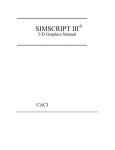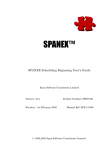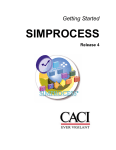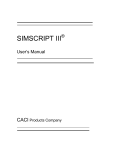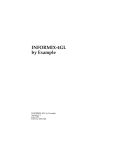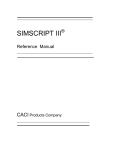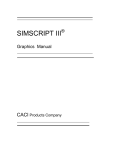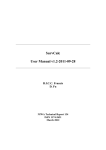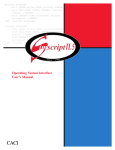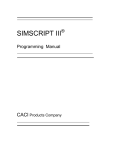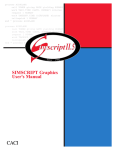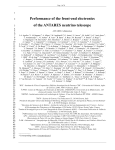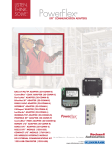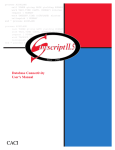Download SIMSCRIPT II.5 Simplified
Transcript
process AIRPLANE call TOWER giving GATE yielding RUNWAY work TAXI.TIME (GATE, RUNWAY) minutes request 1 RUNWAY work TAKEOFF.TIME (AIRPLANE) minutes relinquish 1 RUNWAY end " process AIRPLANE S Since SIMSCRIPT II.5® Simplified 1962 SIMSCRIPT II.5 Simplified This document was produced by Professor Tony Vignaux Victoria University New Zealand [email protected] Updated November 2002 by CACI If there are questions regarding the use or availability of SIMSCRIPT II.5 product, please contact CACI at any of the following addresses: For product Information contact: CACI Products Company 1011 Camino Del Rio South, suite 230 San Diego, California 92108 Telephone: (619) 542-5224 www.caciasl.com CACI Worldwide Headquarters 1100 North Glebe Road Arlington, Virginia 22201 Telephone (703) 841-7800 www.caci.com For technical support contact: Manager of Technical Support CACI Products Company 1011 Camino Del Rio South #230 San Diego, CA 92108 Telephone: (619) 542-5224 [email protected] The information in this publication is believed to be accurate in all respects. However, CACI cannot assume the responsibility for any consequences resulting from the use thereof. The information contained herein is subject to change. Revisions to this publication or new editions of it may be issued to incorporate such change. SIMSCRIPT 11.5 is a registered trademark and service mark of CACI Products Company. 2 TABLE OF CONTENTS 1. 2. Introduction ................................................................................................ 1 Simscript II.5 Language Elements ......................................... 3 2.1 Program Structure............................................................................................ 3 2.2 The Main Program ........................................................................................... 3 2.3 Variables ............................................................................................................ 4 2.3.1 Modes........................................................................................................ 4 2.3.2 Local and Global Variables ................................................................. 5 2.3.3 Arrays ........................................................................................................ 5 2.4 The Preamble .................................................................................................... 5 2.5 The Assignment Statement............................................................................... 6 2.6 Input and Output .............................................................................................. 6 2.6.1 Free-form Input (read) .......................................................................... 6 2.6.2 Quick-and-dirty output (list)................................................................. 6 2.6.3 Output with a Template (print) ........................................................... 7 2.7 Program Flow.................................................................................................... 8 2.7.1 Selector Phrases.................................................................................... 8 2.8 Routines ............................................................................................................. 9 2.8.1 Arguments................................................................................................ 9 2.8.2 Functions ................................................................................................ 10 2.9 3. Predefined Elements ....................................................................................... 11 Simulation with SIMSCRIPT II.5 ........................................ 13 3.1 Simulation Time .............................................................................................. 13 3.2 Entities ............................................................................................................. 14 3.2.1 Creating and using Temporary Entities......................................... 14 3.2.2 Attributes of Entities ............................................................................ 15 3.3 3.4 Sets.................................................................................................................... 16 Processes .......................................................................................................... 17 3.4.1 Defining a Process .............................................................................. 17 3.4.2 Process Routine ................................................................................... 18 3.4.3 Creating a Process Entity.................................................................. 18 3.4.4 Activating a Process with Attributes and Arguments ................ 19 3.4.5 Elapsing Time in a Process .............................................................. 20 3.4.6 A Complete Program Using wait Commands.............................. 20 3.4.7 Interactions of Processes .................................................................. 21 SIMSCRIPT II.5 Simplified 3.4.8 3.5 Interruptions .......................................................................................... 21 Resources ......................................................................................................... 23 Using Resources.................................................................................. 25 3.5.1 3.6 4. Standard Attributes ........................................................................................ 25 Statistical Aspects of Simulation ............................................ 27 4.1 Random Number Generation ........................................................................ 27 4.2 Statistical Monitoring ..................................................................................... 28 Tally ......................................................................................................... 28 Accumulate ............................................................................................ 29 4.2.1 4.2.2 5. Acknowledgments................................................................................ 31 5.1 References........................................................................................................ 31 5.1.1 Footnotes ............................................................................................... 31 ii Abstract SIMSCRIPT II.5 is a powerful simulation language in active use for major simulations, particularly in engineering applications. These notes illustrate just enough of the features so that simple simulations programs can be written. SIMSCRIPT II.5 Simplified b 1. Introduction SIMSCRIPT II.5 is a powerful, free form, English-like, general-purpose simulation programming language. It supports the application of software engineering principles, such as structured programming and modularity, which impart orderliness and manageability to simulation models.'' [(Russell)(1983)] is available for a range of computers including PCs running Windows and NT and also Unix workstations. These notes introduce only a few features of , enough for simple simulations. Many features of the language are left out. You are strongly urged to refer to the more comprehensive information found in the manuals such as [(CACI83)(1997)], and [(CACI89)(1989)], and other books such as [(CACI97)(1997)] and [(Russell)(1983)]. Nor do the notes show how to compile and run programs. The first section is treated as a general-purpose computer language. It has all the programming structures that we are used to seeing in computer languages and it can be used for normal calculations just like Pascal, Java, or Python. The second section describes the special additions that make into a simulation language. These include simulation time, processes, and resources. In the third section the statistical routines used for generating random numbers and for monitoring simulations are described briefly. SIMSCRIPT II.5 Simplified 2 2. Simscript II.5 Language Elements SIMSCRIPT II.5 is a computer language with all the usual elements. 2.1 Program Structure Every program must have a main program. In addition, it may contain a preamble and a number of routines. main program Every program must contain one main program which is the main processing part. preamble This contains all global declarations. It is not always required. If it is included it must be listed before the main program. routines Such as Functions, Subroutines, Events, and Processes. These are not always required but will be needed in simulation programs. 2.2 The Main Program The main program starts with the word main. All blocks finish with end Example 2.1. From time immemorial, the first program that learners write is the one that prints out ``Hello World!''. Here it is in SIMSCRIPT II.5. It consists of just one main block. main print 1 line thus Hello World! end '' main Comments begin with two, single quotes. The rest of the line is treated as a comment and ignored by the compiler. Convention: The comment attached to the end (though it is not needed) indicates the name of the block or routine that is terminating. It used to be the convention that basic words are in lower case and identifiers are in upper case. You will find this in much of the documentation. It is not required. Example 2.2 This is an illustration of a main program. It contains variable declarations, creation of resources, input, process activation, starting a simulation and calling a routine. Don't worry about the details now - they will be explained later. (This would not run by itself) main define title as a text variable define no.of.tellers as an integer variable define lambda and mu as double variables SIMSCRIPT II.5 Simplified create every teller(1) read no.of.tellers, lambda, and mu let u.teller(1) = no.of.tellers activate a customer now start simulation call report '' calling a subroutine end ''main 2.3 Variables Variable names can be any combination of letters, digits, and periods that contains at least one letter or two or more nonterminal periods1. Variables should be explicitly declared with a define variable-list statement which specifies a list of variables as being of a given mode2. Example 2.3 Here we define one variable of integer mode, two of double mode and one of text mode. define Next.Customer as an integer variable define Weight, Length, and Height as double variables define my.title as a text variable The variable-list can take a number of alternative forms. The variable names can be separated by any of the following: ``,'' or ``and'' or ``, and''. The choice is up to you and is intended to make the program more readable. See [(CACI83)(1997)]. Similarly, the word an (which could be a) in the first definition, above, is optional and is there for readability3. Convention: All variable names must be defined explicitly. 2.3.1 Modes Variables can be of a number of modes (called types in other languages): • integer • real • double (increased precision reals) • text (for strings of text) • pointer integer, real, and double modes are intended for numerical calculations, text for string handling, and pointer for handling temporary entities and processes (to be considered in Section 3.2.1). At the start of a program all variables are initialized to zero or a blank value. 4 SIMSCRIPT II.5 Language Elements 2.3.2 Local and Global Variables A variable is only known within the routine it is defined in. It is a local variable. Variables declared in the preamble (Section 2.4) are global and are know and can be used throughout the program. 2.3.3 Arrays SIMSCRIPT II.5 does have arrays. They are defined as follows: Example 2.4 Defining 1- and 2-dimensional arrays. define Vector as a 1-dimensional integer array define Matrix as a 2-dimensional, real array Before an array can be used its dimensions must be reserved (in the main block or a subprogram, not in the preamble). This allows one to have arrays where the number of elements is not known until the program is running4. Example 2.5 Reserving dimensions for the arrays defined in Example 2.4. The first line provides a 10-element vector of integers, referred to as Vector(1) to Vector(10). The second a 5 by 7 matrix of real numbers whose elements are referred to as Matrix(i,j), for example. reserve Vector as 10 reserve Matrix as 5 by 7 2.4 The Preamble The preamble is the section where global variables are defined. It must precede the main program and other routines and contain no executable statements. To ensures that any variables not declared are flagged by the compiler the preamble must contain the line normally, mode is undefined Example 2.6 A preamble showing declarations of two processes, some resources and a number of global variables. The tally and accumulate statements set up statistical monitoring routines. Don't worry about the details at the moment. The idea is to see the sorts of declarations that occur in a preamble. It has no executable statements. preamble normally, mode is undefined processes every customer has an Arrival.time define Arrival.time as a real variable resources include Teller define no.of.tellers, and no.of.customers 5 SIMSCRIPT II.5 Simplified as integer variables define Time.in.bank and Waiting.time as real variables tally Avg.Wait as the average of Waiting.time accumulate Avg.Line as the average of N.Q.Teller end '' preamble 2.5 The Assignment Statement All statements start with a key word such as let, add, subtract (though the let can be eliminated if preferred). Example 2.7 The first two lines show assignments with the let key word; The next shows an assignment without let. The next is an arithmetic assignment and the last two show what are effectively assignments using add and subtract. let Teller = 1 let closing.time = closing.time/hours.v Number.of.Tellers = 10 '' key word 'let' is omitted here let no.of.customers = no.of.customers + 1 add 1 to no.of.customers subtract 1 from no.of.customers 2.6 Input and Output In this introduction we will use only a simple free-format read statement and one simple and one formatted print statement. More complicated ones are available. 2.6.1 Free-form Input (read) The free-form read variable-list statement is the simplest form of input. The variable-list can have variables of any mode. Data can be entered from the terminal (i.e. the system input file) or read from a file5. Be careful with variables of mode text as the value entered cannot contain blanks. Example 2.8 This read statement assigns values to the 4 variables. Note that in , statements are not limited to a single line. read no.of.tellers, lambda, title and closing.time Since the list of variables6 can use both commas and the word and we could also write the above read statement like this: read no.of.tellers, and lambda, and title, and closing.time 2.6.2 Quick-and-dirty output (list) 6 SIMSCRIPT II.5 Language Elements This is used to help in debugging but should not be used in the final forms of programs in assignments. The list variable-list displays the values of the variables in the variable-list on the screen. Example 2.9 This list statement prints the values of variable x, lambda and no.of.tellers: list x, lambda, and no.of.tellers This results in the following output. X= 2.0000000000 LAMBDA = 5.3300000000 NO.OF.TELLERS = 4.0000000000 2.6.3 Output with a Template (print) The print variable-list thus statement, introduced here, is the main form of output we will use in the course7. It prints the values of every variable in the variable-list in a form specified by a template. The template is a pattern showing how the values are to be presented. It can contain words other than the data being printed. Every variable in the variable-list will have a corresponding asterisk (*) pattern. Integer and text mode variables should be printed with the form *** (the number of * indicating how many digits or characters to print). Real and double mode variables will have a pattern including a decimal point somewhere (such as ***.** for a value with 3 digits or spaces before the decimal point and 2 after it). Example 2.10 The general form is print N lines with {variable-list} thus {N lines of template with one group of *** or ***.** for every variable} However you must be careful to count the exact number of lines used. One common error is to use too few lines and try and print from the next line which may be part of the program. Convention: Leave an extra blank line after a print statement. Example 2.11 This print statement prints 5 lines with values of the 7 variables or arithmetic expressions. print 5 lines with no.of.tellers, lambda, mu, and closing.time*hours.v, Avg.Line, Avg.no.of.Custs, and Avg.Wait*Minutes.per.day thus N= ** lambda= **.** mu= **.** closing time = ** Avge line = *.** Avge customers = *.** Avge wait = ***.** '' next program line here, thus leaving a blank 7 SIMSCRIPT II.5 Simplified '' after the print statement for safety. 2.7 Program Flow SIMSCRIPT II.5 has all the usual program structures, such as if-then-else (or if-elseendif), for-do-loop, until and while loops, etc8. The if structure has no then, and the statement is terminated by endif9. The else part can be omitted but the endif must be retained. Example 2.12 An example of the if structure: if A > B let Maxvalue = A read C else let Maxvalue = B read D endif while loops are similar to until loops. For all the iterative structures, the group of statements to be executed must be surrounded by a do-loop pair. Example 2.13 Some examples of looping program structures. Here, in each case, 100 values are read sequentially into the vector x() for i = 1 to 100 do read x(i) loop let i = 1 until i > 100 do read x(i) add 1 to i loop let i = 1 while i <= 100 do read x(i) add 1 to i loop 2.7.1 Selector Phrases The for, while, and until statements can be enriched by using one or more selector phrases to accept or reject a loop iteration. The when and unless phrases test the value of a logical expression and execute the inside of the loop if appropriate. Example 2.14 Here baggage is only counted if it is over 1 except if it belongs to Vignaux. 8 SIMSCRIPT II.5 Language Elements for count = 1 to No.of.seats when Baggage(count) > 1 unless Owner(count) = "Vignaux" do add Baggage(count) to Total loop 2.8 Routines Routines in SIMSCRIPT II.5 are like subroutines or procedures in other programming languages. They are declared after the main block and not inside it. They are called from other subprograms ( not the preamble). Of course, they may define local variables and use global variables. Example 2.15 Here a routine is defined. It has a local variable, i and refers to Num.Ambulances which, we assume, is global and defined in the preamble. routine Initialise define i as an integer variable read Num.Ambulances let i = 0 until i eq Num.Ambulances do let i = i + 1 create an Ambulance activate this Ambulance now loop end '' routine Initialise Routines are executed using the call statement. For example: Example 2.16 Executing a routine using a call statement: call Initialise 2.8.1 Arguments Routines can be given arguments and return results. The arguments supplying data are separated from those returning the result. This is done using the keywords given and yielding. Arguments behave like local variables and their mode must be declared immediately after the routine heading. As they are local to the routine, they can be given any names you like. Example 2.17 This routine calculates the value of Profit given the amount of Production. routine Profit.Calc given Production yielding Profit define Production, Profit as double variables '' arguments define Fixed, Contribution as double variables '' local 9 SIMSCRIPT II.5 Simplified let Fixed = 10000.0 let Contribution = 20.0 let Profit = - Fixed + Contribution*Production end '' Profit.Calc Example 2.18 The above routine would be called like this: call Profit.Calc given 50000.0 yielding The.Profit Instead of given you can enclose the given arguments in parentheses, ( ). Convention We usually declare and call routines with a list of given arguments enclosed in parentheses. You don't need the word given then. Example 2.19 For example, the above definition could be written: routine Profit.Calc(Production) yielding Profit define Production, Profit as double variables '' ..... lots of calculations .... end '' Profit.Calc Example 2.20 We could call the routine like this: call Profit.Calc(50000.0) yielding the.Profit A routine finishes when the program ``drops off the end'' of the routine. You can finish at another part by the return statement. WARNING: does not automatically convert integer mode arguments to real or double. So don't forget to put the decimal point in real or double arguments when you call a routine! 2.8.2 Functions Functions are routines that return a value and can be called as part of an arithmetic expression. The value is returned by using the return with or the return() statement. They are not executed using the call statement like routines but are used within expressions to return a value. They must be defined as functions in the preamble. In this definition you can set the mode and you can (and should) state the number of given arguments. Remember that the arguments and any other local variables are not recognized outside the function. The only communication with the main and other routines is via the arguments in the call command and the return value10. Of course there are also many pre-defined functions, which you do not have to define yourself. Example 2.21 We define a Normal.fn. In the preamble we define it as a double function and specify the number of arguments: preamble normally, mode is undefined define Normal.fn as a double function given 2 arguments end '' preamble 10 SIMSCRIPT II.5 Language Elements Example 2.22 The function code would appear after the main block and would look something like this: function Normal.fn (Mean, Std.Dev) define Mean and Std.Dev as double variables ... return(XXX) '' some arithmetic result end '' Normal.fn Example 2.23 It would then be called like this: let x = Normal.fn(10.0,2.1) '' note the decimal points for doubles ! Here is an example of a complete multiplies two variables. program with a preamble and a function that Example 2.24 The multiply function is declared in the preamble and defined later. It is called in the main block. preamble normally, mode is undefined define x,y, and z as double variables define multiply as a double function given 2 arguments end ''preamble main read x,y let z = multiply(x,y) print 1 line with x,y,z thus ****.** times ****.** is *******.** end '' main function multiply(a,b) '' Definition of the function define a,b as double variables return (a*b) end '' multiply 2.9 Predefined Elements There are many pre-defined functions, routines, variables and constants11. You do not have to define these. Pre-defined elements have special suffices, for example: .f for functions, .r, for routines, .v for variables, and .c for constants. Some examples are: Function abs.f(arg) absolute value of arg Routine date.r the current date Variable hours.v hours per day value of Constant pi.c 11 SIMSCRIPT II.5 Simplified 12 3. Simulation with SIMSCRIPT II.5 We now look at some of the special facilities provides for the simulation programmer. They include entities, sets, processes, resources, and, importantly, ways of recording and elapsing simulation time. 3.1 Simulation Time All discrete-event simulation programs have the simulation time maintained in a software clock. In this is called time.v time.v is a double variable. It is sed to record and print out the current simulation time particularly in controlling the simulation and in producing traces of its operation12. Do not attempt to alter time.v yourself. Time is measured in units13 During the running of a simulation program, time steps forward from one event to the next. An event occurs whenever the state of the simulated system changes. For example, an arrival of a customer is an event. So is a departure. Execution of this timing mechanism does not start until the following statement appears in the main block of the program: start simulation The simulation then starts, the timer routine seeking the first scheduled event14. It continues to run until there are no further events to execute. This is the usual method of ending a simulation. More statements can be executed after the simulation (like the call Report in Example 3.1). The program can be terminated using the stop statement. Example 3.1 This shows only the main block in a simulation program. Activating the PoissonProcess has the effect of scheduling at least one event15. The start simulation will make the programme jump to that event When the simulation ends the Report routine is called. main call Initialise activate a PoissonProcess now start simulation call Report end '' main SIMSCRIPT II.5 Simplified 3.2 Entities Before we look at processes we must look briefly at entities. An entity is an element of the system being simulated that can be individually identified and processed16. In they can be either permanent or temporary. They are defined in the preamble using either an include or an every declaration statement (every statements will be dealt with in Section 3.2.2.) Example 3.2 Defining some entities. preamble normally, mode is undefined permanent entities include Teller, Computer temporary entities include customer, Task .... end '' preamble We will not say much about permanent entities in this simplified version of the language though they will be used, in the form of resources (see Section 3.5). 3.2.1 Creating and using Temporary Entities Temporary entities must not only be defined in the preamble, they must be created before they can be used. Example 3.3 Assuming that the customer has been defined as a temporary entity we can create it as follows17: create a customer When a temporary entity, say customer, is created: • a section of memory is allocated to hold its attribute values (see section 3.2.2 to find out what attributes are) and • a single global variable customer points to this memory space. When we create another customer, the same global integer variable customer then points to the location of the new entity. (c.f. the new statement in many modern languages). We would not use that global value but define and use a pointer variable to refer to the new entity. So it is better (and our convention) to create temporary entities in the following form (where PV is previously defined as a pointer variable). PV can then be used to refer to the new entity. Example 3.4 Creating a customer with a pointer that can be used to refer to it. create a customer called PV An entity can later be destroyed. It is best to do this by way of the pointer variable. Just as the create statement needed the entity as well as the pointer, so does the destroy statement. 14 Simulation with SIMSCRIPT II.5 There is an important difference between the create and destroy statements. We create a customer called PV but destroy the customer called PV. Example 3.5 Here we define pointer variables Fred and Valerie which are used to access the two different temporary customer entities. We then get rid of Fred using the destroy the command. Note the different usage of a and the in the two statements. define Fred, Valerie as pointer variables ... create a customer called Fred create a customer called Valerie ... destroy the customer called Fred 3.2.2 Attributes of Entities An attribute is a property of an entity that conveys extra information about it. Attributes can be used to identify a sub-class of entities (e.g. red cars) or values for an individual entity (a customer number) or to control its behavior. The programmer can define attributes for the entities in the program. We define an entity with attributes by the every statement in the temporary entities section of the preamble, instead of the include statement. You state what attributes the entity has and define their modes. Convention: The modes of attributes of entities are defined immediately they are specified and are given names that start with a prefix indicating the entity that they belong to. Example 3.6 Here we define temporary entities without (Task) and with (customer) attributes: preamble normally, mode is undefined temporary entities include Task ''(no attributes) every customer has a cu.Arrival.time define cu.Arrival.time as a double variable ... end '' preamble Later in the program you can use the attribute, indexed by the global entity name or a pointer variable Example 3.7 Using the Fred pointer variable to set the Arrival.time for that particular customer. main define Fred as a pointer variable ... create a customer called Fred let cu.Arrival.time(Fred) = 11.4 ... end '' main 15 SIMSCRIPT II.5 Simplified 3.3 Sets A set is an ordered list of entities, like a queue. Sets must be defined in the preamble and must have an owner. The owner is often another entity. In some cases this is not appropriate so we can specify that a general-purpose owner, the system, can own a set. When you define an entity in the preamble, you must specify what sets it can belong to and what sets it owns. Example 3.8 Here, each of the Job entities has its own list of Tasks to be done, the Task.list held as a set. The Job can be put on (it belongs to)18 the single Job.queue which is owned by the system. preamble temporary entities every Task has a Tk.duration, and belongs to a Task.list define Tk.duration as a double variable every Job has an Jb.arrival.time, owns a Task.list, and belongs to a Job.queue the system owns the Job.queue ... end '' preamble Sets (queues), if not further defined, are assumed to have a normal FIFO (First-in, firstout or First-come, first served). Otherwise they can be defined as being a LIFO set. Alternatively a set can be ranked by combinations of attributes of the entities that can belong to it. This is specified when the belongs phrase is used (See the define .. as a set ... in Example 3.9). Example 3.9 Here the Task.list contains Tasks filed in order of low values (ascending order) of Tk.duration. temporary entities every Task has a Tk.duration, and belongs to a Task.list define Tk.duration as a double variable define Task.list as a set ranked by low Tk.duration Entities are put into and removed from sets by statements in the routines of the program. They are added to a set using the file statement (See line 5 in Example 3.10), and taken out using the remove statement (Line 7 in Example 3.10). The entities are filed in the appropriate order automatically. Sets have a number of standard attributes, automatically defined and updated for you (see Section 3.6). A most useful one is the number of entities in the set. For a set called Q, the 16 Simulation with SIMSCRIPT II.5 number of entities it holds is N.Q. This is automatically updated whenever entities are added to or removed from the set. You can test if a set is empty or not using the forms Q is empty or Q is not empty. You can also ask if a particular entity, say E, is in the set using: E is in Q or E is not in Q. Example 3.10 (following on from Problem 3.8) Here we create a Job100 and a Task which is put onto Job100s Task.list. The print statement (6) outputs the number in the Task.list. We can remove the task from the set (7). The particular statement used does not destroy the task and it can be accessed using tt. 1) define Job100, and tt as pointer variables ... 2) create a Job called Job100 3) create a Task called tt 4) let Tk.durationn(tt) = 100.0 5) file tt in the Task.list(Job100) ... 6) print 1 line with N.Task.list(Job100) thus Number in task list is **** .... 7) remove the first tt from the Task.list(Job100) ... 8) if the Task.list(Job100) is empty 9) print 1 line thus 10) Set is empty 11) 12)endif 3.4 Processes We now come to the main tool for discrete-event simulation. A process is a sequence of events that describes the experience of an entity as it lives its lifetime. For example, a message turns up in a computing network; it makes transitions between nodes, waits for service at each one, and eventually leaves the system. All these are events. In a process is represented as an entity associated with a process routine that describes the life-cycle. This entity is a temporary entity (but is defined in a separate section of the preamble as a process). A process can have attributes. Different individual processes (e.g. individual customers) are created as the program runs. The routine, which describes the sequence of events, is called the process routine and is written in the program as a routine with the same name as the entity. 3.4.1 Defining a Process A process entity is defined with or without attributes in a processes section of the preamble. Processes can own and belong to sets. 17 SIMSCRIPT II.5 Simplified Example 3.11 Here we define a message process (with no attributes), a clock, and a customer process (with attributes). preamble normally, mode is undefined processes include message '' a process with no attributes every clock has a cl.int define cl.int as a real variable every customer has an cu.Arrival.time define cu.Arrival.time as a real variable end '' preamble 3.4.2 Process Routine The process routine is, like other routines, declared after the main block but uses the keyword process. Its name must be that of the process defined in the preamble. The process starts executing the routine when it is activated. Example 3.12 A process routine for a ticking clock. int is the time interval between ticks. It would be defined as an attribute of the process entity and an argument of the process routine. process clock(int) define int as a double variable define i as an integer variable for i = 1 to 10 do print 1 line with time.v thus ***.*** tick wait int units loop end '' clock 3.4.3 Creating a Process Entity A new process entity appears when the process is created or activated. To create and start a new process in one step, use the activate statement. Pointer variables can be used to reference such new processes. Example 3.13 We activate two messages immediately. the word a indicates that we are both creating and activating new messages (they have no attributes). The word now implies no simulation delay before the process starts. activate a message now activate a message called mmm now 18 Simulation with SIMSCRIPT II.5 It is also possible to give values to the attributes of the process before it is activated. This is done by first creating it, setting the attribute values and then activating it. Example 3.14 Here the customer is created first, given an attribute value, then activated. The word the is used to indicate we are not creating a new customer when we activate. The attribute cu.Arrival.time here records the time the customer is created. create a customer called Fred let cu.Arrival.time(Fred) = time.v activate the customer called Fred now Processes do not have to be activated immediately. Example 3.15 Here we activate a Job to start at some (random) time in the future and activate a customer (to be called Fred) immediately, and a bus when time.v becomes 120.0 time units. The word a indicates that these processes are being created. activate a Job in exponential.f(13.33, 2) hours activate a customer called Fred now activate a Bus called b at 120.0 units 3.4.4 Activating a Process with Attributes and Arguments A process with attributes may have a corresponding routine with arguments that correspond in mode but not name to the attributes of the process entity. Example 3.16 For the customer process definition shown in Example 3.11, a corresponding process routine fragment might be: process customer(ArrTime) define ArrTime as a real variable ... end '' customer We can then activate the process and at the same time assign a value of 13.3 to the attribute cu.Arrival.time by either of the following methods: 1. Assign an cu.Arrival.time with the value of the process argument, ArrTime, when the routine starts. Example 3.17 Process argument used19: activate a customer called Fred given 13.3 now 2. Set the value of the attribute and then activate the process. This ignores the process argument: Example 3.18 3-step process: create a customer called Fred let cu.Arrival.time(Fred) = 13.3 activate the customer called Fred now However, a process attribute, such as cu.Arrival.time, and a process routine argument, such as ArrTime, cannot have the same name20. 19 SIMSCRIPT II.5 Simplified 3.4.5 Elapsing Time in a Process Within a process routine the process can wait or work for some time interval measured in units. (It can also request and relinquish resources as described later in Section 3.5). In this way it can simulate the elapsing of time. Example 3.19 The process will hold for a random time with mean 10.0 units. work exponential.f(10.0, 3) units wait and work are effectively synonymous but work is more appropriate if a resource is being used. A process disappears when it is destroyed or when it runs off the end of its routine. Convention: we do not usually destroy processes. instead, allow them to run off the end of the routine. 3.4.6 A Complete Program Using wait Commands Example 3.20 This program simulates a firework with a time fuse. It contains a preamble to define the firework process. I have put in a few extra wait commands preamble normally mode is undefined processes include firework end '' preamble main activate a firework in 20.0 units start simulation end ''main process firework define i as an integer variable print 1 line with time.v thus *****.** firework activated wait 10.0 units for i = 1 to 10 do wait 1.0 unit print 1 line with time.v, and i thus *****.** tick ** loop wait 10.0 units print 1 line with time.v thus *****.** Boom!! end '' process firework The output from the program in Example 3.20 is : 20.00 firework activated 31.00 tick 1 20 Simulation with SIMSCRIPT II.5 32.00 tick 2 33.00 tick 3 34.00 tick 4 35.00 tick 5 36.00 tick 6 37.00 tick 7 38.00 tick 8 39.00 tick 9 40.00 tick 10 50.00 Boom!! One useful program pattern is the generator (See Example 3.21). This is a process that generated events or activates a number of other processes as a sequence - it is a source or generator of other processes. Random arrivals are generated using such a process. Example 3.21 The generator pattern. A process to generate a series of customers to arrive at intervals of 10.0 units of time. To achieve ``random'' arrivals of customers the wait statement should use an exponential random variate instead of, as here, a constant 10.0 value. process Generator while time.v < Finish.time do activate a customer now wait 10.0 units loop end '' Generator 3.4.7 Interactions of Processes The various states that a process can exist in are shown in this diagram: An executing process can suspend itself and can be sent a reactivate command by another process. Example 3.22 The process itself would say suspend and (some other process) would reactivate using the form: Example 3.23 reactivation by a second process. reactivate the customer called Fred now 3.4.8 Interruptions A pending process (one that is waiting for an event to occur) can be interrupted and later resumed by another routine. Example 3.24 Here we are in some routine (not the customer routine. The customer called Fred is interrupted, filed in a set. It is held there for 20.0 units and then resumed. interrupt the customer called Fred now 21 SIMSCRIPT II.5 Simplified file Fred in Interrupted.Set wait 20.0 units remove the first customer called Fred from the Interrupted.Set resume the customer called Fred Example 3.25 In this program example the Arrival.Generator is interrupted by the terminating process Close.Doors. This routine prints out a report and then stops the program, even though some processes have not yet finished. First we look at the preamble and main blocks. preamble normally mode is undefined processes include Arrival.Generator,and Close.Doors every customer has a cu.number define cu.number as an integer variable define Day.Length, Mean, sojourn as real variables define count.departs, and count.arrivals as integer variables end '' preamble main call Read.Data ''reads 3 global variables count.departs = 0 count.arrivals = 0 activate an Arrival.Generator now activate a Close.Doors in Day.Length units start simulation '' it starts operating here call Report end '' main Example 3.26 Following on from Example (3.25) we list the processes and routines. process Arrival.Generator define i as an integer variable for i = 1 to 1000000 do wait exponential.f(Mean,1) units activate a customer(i) now add 1 to count.arrivals loop end '' Arrival.Generator process customer(id) define id as an integer variable print 1 line with time.v, and id thus ***.*** customer *** arrives wait exponential.f(sojourn,2) units print 1 line with time.v, and id thus ***.*** customer *** departs add 1 to count.departs end ''customer process Close.Doors interrupt Arrival.Generator 22 Simulation with SIMSCRIPT II.5 call Report stop end ''Close.Doors routine Read.Data read Day.Length, Mean, and sojourn end '' Read.Data routine Report print 2 line with count.arrivals and count.departs thus ***** customers arrived ***** customers departed end '' Report Example 3.27 An example of the trace output from a run of this program is as follows: .078 customer 1 arrives 1.803 customer 2 arrives 3.219 customer 3 arrives 3.242 customer 4 arrives 3.619 customer 3 departs 4.643 customer 5 arrives 4.803 customer 6 arrives 5.146 customer 1 departs 5.222 customer 7 arrives 5.404 customer 8 arrives 5.654 customer 8 departs 5.847 customer 7 departs 6.315 customer 9 arrives 6.860 customer 2 departs 7.285 customer 6 departs 7.765 customer 10 arrives 7.882 customer 9 departs 10 customers arrived 7 customers departed 3.5 Resources A resource models a congestion point where there may be queuing. For example in a manufacturing plant, a Task (modeled as a process) needs work done at a particular sort of Machine (modeled as a resource). If not enough Machines are available; the Task will have to wait until one becomes free. The Task will then have the use of a Machine for however long it needs. It is not available for other Tasks until it is released. These actions are all automatically taken care of by the resource. A resource can have a number of different types. There may be three types of Machine resource, perhaps, lathe, cutter, and polisher. A Ship may be a tanker, a general cargo ship, or a ferry. Each different type of a resource has a number of units. This records how many of that type there are initially. 23 SIMSCRIPT II.5 Simplified In a resource is modeled as a special kind of permanent entity. A process gets service by requesting and, when it is finished, by relinquishing the resource. A resource maintains a set (a queue or list) of processes using units of each type the resource and another set of processes waiting for units of it. These sets are defined and updated automatically. Resources are defined in the preamble in a special section labelled resources. A resource can have user-defined attributes. Example 3.28 Here Teller is defined as a resource without user-defined attributes. Ma.name is a user-defined attribute for the resource Machine. resources include Teller every Machine has a Ma.name define Ma.name as a text variable A resource also has standard attributes defined automatically (See Section 3.6). These record how many units of each type of the resource are free, how many processes are waiting for it, etc. For example, the number of types of a resource R is held in the variable N.R. Type i is referred to as R(i) where i = 1 to N.R. Each type has a number of units. The number of units of type i is referred to as U.R(i). Once a resource has been defined in the preamble it must have storage allocated for its attributes in the main block21. First you must specify the number of types (N.R); then you create all the types (create every R), then you specify how many units of each type (U.R(i)). Example 3.29 A group of Machines (a resource) might have 2 different types (N.Machines = 2).There can be different numbers of units of each type: let N.Machines = 2 '' the number of TYPES create every Machine ''creates storage let U.Machine(1) = 4 '' the number of UNITS of type 1 let U.Machine(2) = 1 '' the number of UNITS of type 2 You can get information about the set of processes that are using units of the resource and those of processes that are waiting. For resource R the set using units of type i is known as X.R(i); the set waiting for it as Q.R(i). Then, of course, since Q.R(i) is a set, we can find out how many processes are waiting from the set attribute N.Q.R(i). Example 3.30 for the Machines, in Example3.29, look at type 1 Machines only (there are 4 of them) Q.Machine(1) '' the set of processes waiting for a '' type 1 Machine N.Q.Machine(1) '' the number of processes waiting X.Machine(1) '' the set containing resources using '' units of a type 1 Machine N.X.Machine(1) '' the number of processes using units 24 Simulation with SIMSCRIPT II.5 3.5.1 Using Resources The process routines will contain statements to interact with the resource. These are the request and the relinquish statements. To use a resource for a time a process will request a number of units of the particular type. If they are available they are allocated to the process, which then holds them until releasing them. If they are not available, the processes will he held on the waiting queue until some come free. The process will suspend its operation until it receives its request. See Example (3.31). On finishing with the resource the process must release it using the relinquish statement, saying how many units of what type are to be released22. Example 3.31 Here the Job requests, and if necessary waits for, one unit of a Machine of type 2. On acquisition it then holds it while it works for a random time (exponentially distributed, mean 20.0) units and then relinquishes it again. process Job request 1 Machine(2) work exponential.f(20.0,3) units relinquish 1 Machine(2) end '' Job 3.6 Standard Attributes Entities, sets, processes and resources have predefined standard attributes in addition to those defined by the user. These are listed in the manuals. Only a few are tabulated here: Some automatically generated attributes routines and variables Entities variable entity global variable variable N.entity no of entities in class (only permanent entities) Processes attribute time.a next scheduled entry time for the process Resources set Q.resource set of processes waiting for this resource set X.resource set of processes using this resource attribute U.resource number of idle units attributes F.set first entity in set of owner L.set last entity in set entities N.set number of entities in set attributes P.set pointer to predecessor in set Sets Sets 25 SIMSCRIPT II.5 Simplified of member S.set pointer to successor in set entities equals 1 if entity is in the set, 0 otherwise M.set Thus the processes waiting for a resource R are listed in the set Q.R and the variable N.Q.R tells you how many there are. To list them, you would start at F.Q.R which is the first one waiting. If First.one = F.Q.R, the next one waiting is S.First.one (the successor to the first one). 26 4. Statistical Aspects of Simulation SIMSCRIPT II.5 provides a number of statistical facilities. These include random variate generation with different seed streams and statistical monitoring methods. See [(CACI)(1997)][Section 5.3]. 4.1 Random Number Generation There are 10 random number streams, numbered S = 1 ... 10. At any instant each stream has an integer seed value, which is updated every time the stream is called on for a random number. All the seed values are different. A stream's seed value can be found from the variable seed.v(S). The stream is updated using one of the random variable functions. All these have the stream as a parameter and update that stream one or more times whenever they are called. Example 4.1 Generating a random variable from stream 3. let S = 3 let X = random.f(S) In this example, the seed value for stream 3 is updated to the next ``random'' integer and the real value X = seed.v(3)/(2311) is returned as a real random variable23. Thus 0 < X < 1. Thus random.f(S) generates apparently uniform random deviates between 0 and 1. It uses one of the 10 random number seed variables. Each seed sequence of random integers is supposedly independent of of the others. The initial values of the seed integers (the starting seeds) from each of the STREAMs are initialized by at the start of a run. They are listed at the start of Appendix C of [(Russell)(1983)]. For example, seed.v(1)=2116429302. You can supply your own initial integer values if you want: Example 4.2 Set the initial seed value for stream 3 to 2345. let seed.v(3) = 2345 Pseudo-random variables can be generated from a number of distributions24: • binomial.f(N,P,STREAM) • erlang.f(Mean,K,STREAM) • exponential.f(Mean,STREAM) • gamma.f(Mean,K,STREAM) • log.normal.f(Mean,StdDev,STREAM) SIMSCRIPT II.5 Simplified • normal.f(Mean,StdDev,STREAM) • randi.f(Start,Finish,STREAM) • uniform.f(Start,Finish,STREAM) These routines contain calls to random.f(STREAM) and use the corresponding seed stream. Example 4.3 To generate a sample, x, from an exponential distribution with mean 20.0, using STREAM 1, one would use the following call. Notice that I have been careful to put in a decimal point into the first argument which must be real. x = exponential.f(20.0,1) NOTE: You must use real values if a routine requires a real argument. For example exponential.f(3, 1) will not give you a sample from an exponential with mean 3. Instead, you must use the call exponential.f(3.0, 1). does NOT automatically convert arguments from integer to real. 4.2 Statistical Monitoring Any global variable can be automatically monitored by the system to calculate statistics. Little change has to be done to the program except by the addition of a special statement in the preamble. The two types of monitoring are tally and accumulate. 4.2.1 Tally tally takes a sample every time the variable is changed. It is intended to monitor a number of individual observations, such as waiting times. Example 4.4 here in the preamble we define two global variables25 and then indicate that they are to be monitored using the tally statement. The tally statement specifies that we want to find both the mean and standard deviation of the values of the waiting.time. preamble ... define Waiting.time and Time.in.bank as real variables ... tally Avg.Wait as the mean , and Sd.Wait as the std.dev of Waiting.time ... end ''preamble Later in the main part of the program the mean and standard deviation of the Waiting.time can be used: print 1 line with Avg.Wait and Sd.Wait thus Waiting time: mean = ****.***, sd = ****.*** 28 Statistical Aspects of Simulation 4.2.2 Accumulate accumulate is intended to monitor variables that are continuous in time such as the length of a queue. Although it changes discretely, there is always a queue length existing26. accumulate calculates the time-integrals of the value such as the average queue length. Example 4.5 Here the queue at the Teller is to be monitored to determine the average of the number waiting for the Teller (held in N.Q.Teller). preamble ... resources include Teller .. accumulate Avg.Line as the mean of N.Q.Teller ... end '' preamble Then in the main part of the program we could find out the average length of the line so far: print 1 line with Avg.Line thus The average number waiting so far is ****.*** tally and accumulate can calculate a number of different statistics: number, sum, mean, sum.of.squares, mean.square, variance, std.dev, maximum, minimum. 29 SIMSCRIPT II.5 Simplified 30 5. Acknowledgments Students in OPRE352 and COMP349 classes have, year by year, improved these notes by their comments and questions. I am also particularly grateful to Jay Braun, the author of the Reference Handbook, [(CACI83)(1997)], and now with JPL, who kindly corrected a number of mistakes and suggested changes. I will be grateful for any corrections or suggestions for improvements to the document from students, experts, or anyone accessing it over the Web. My email address is [email protected]. 5.1 References [(CACI83)(1997)] CACI83 (1997). SIMSCRIPT II.5 Reference Handbook. C.A.C.I, 2nd edition. [(CACI89)(1989)] CACI89 (1989). UNIX SIMSCRIPT II.5 User's Manual. C.A.C.I. [(Law and Larmey)(1984)] Law, A. M. and Larmey, C. S. (1984). An Introduction to Simulation using SIMSCRIPT II.5. C.A.C.I. [(CACI97)(1997)] CACI97 (1997). SIMSCRIPT II.5 Programming Language. C.A.C.I. [(Pidd)(1992)] Pidd, M., editor (1992). Computer Simulation in Management Science. Wiley, 3rd edition. [(Russell)(1983)] Russell, E. C. (1983). Building Models with SIMSCRIPT II.5. C.A.C.I. 5.1.1 Footnotes 1 II.5 disregards all periods written at the end of names and numbers. Thus the names flight...and flight.. become flight when the program is compiled. (SIMSCRIPT II.5 Reference Manual) You can have periods within an identifier. 2 3 In the word ``mode'' is used instead of ``type'' Don't read this! If a name is not explicitly declared, will declare it implicitly with double mode. Implicit declaration is strongly discouraged because it can lead to errors that are hard detect. We forbid this using a command in the preamble (see the beginning of Section 2.4). SIMSCRIPT II.5 Simplified 4 Arrays can be multiply-dimensioned and can even be ``ragged'' where the rows are not all of the same length 5 In Unix systems, such a file can be read by redirection. For example, when running program harbour that is written to read from the terminal and write to the terminal, without changing the program we can make it read from datafile and write the results to file results. using: harbour < datafile > results 6 See the definition of variable list in the Reference handbook 7 See the documentation for others 8 it also has a case statement 9 Or always, otherwise 10 Or in Global variables 11 See the Reference Handbook 12 A trace is an output record that lists every event and the simulation time it occurred. It is essential for debugging simulation code and can also be analyzed after a run to produce statistical results. We will be using traces frequently. 13 Other time units are days. hours and minutes. Convention: unless the simulation is actually operating in days, hours and minutes, the term units will be used to measure time. 14 At least one process must be activated before the simulation is started otherwise no simulation will occur 15 See section 3.4 to find out more about processes 16 [(Pidd)(1992)] treats entities more fully. 17 The a is important 18 You can use may belong to or can belong to instead of belongs to 19 I get an error if the bracketed method is used though it is documented in the Reference handbook 20 If this sounds a bit complicated, that is because it is. For comments on this, see [(Law and Larmey)(1984)]. 21 or in another routine 32 Acknowledgements 22 If you do not balance the request and relinquish pair your program may grind to a halt 23 Because the largest integer that the seeds can take is (2311) 24 Yes, Valerie, there is a poisson distribution [poisson.f(Mean,STREAM)] but it is never used in simulations. Understand? Never! 25 Remember you can only tally global variables 26 though it may sometimes be zero 33










































